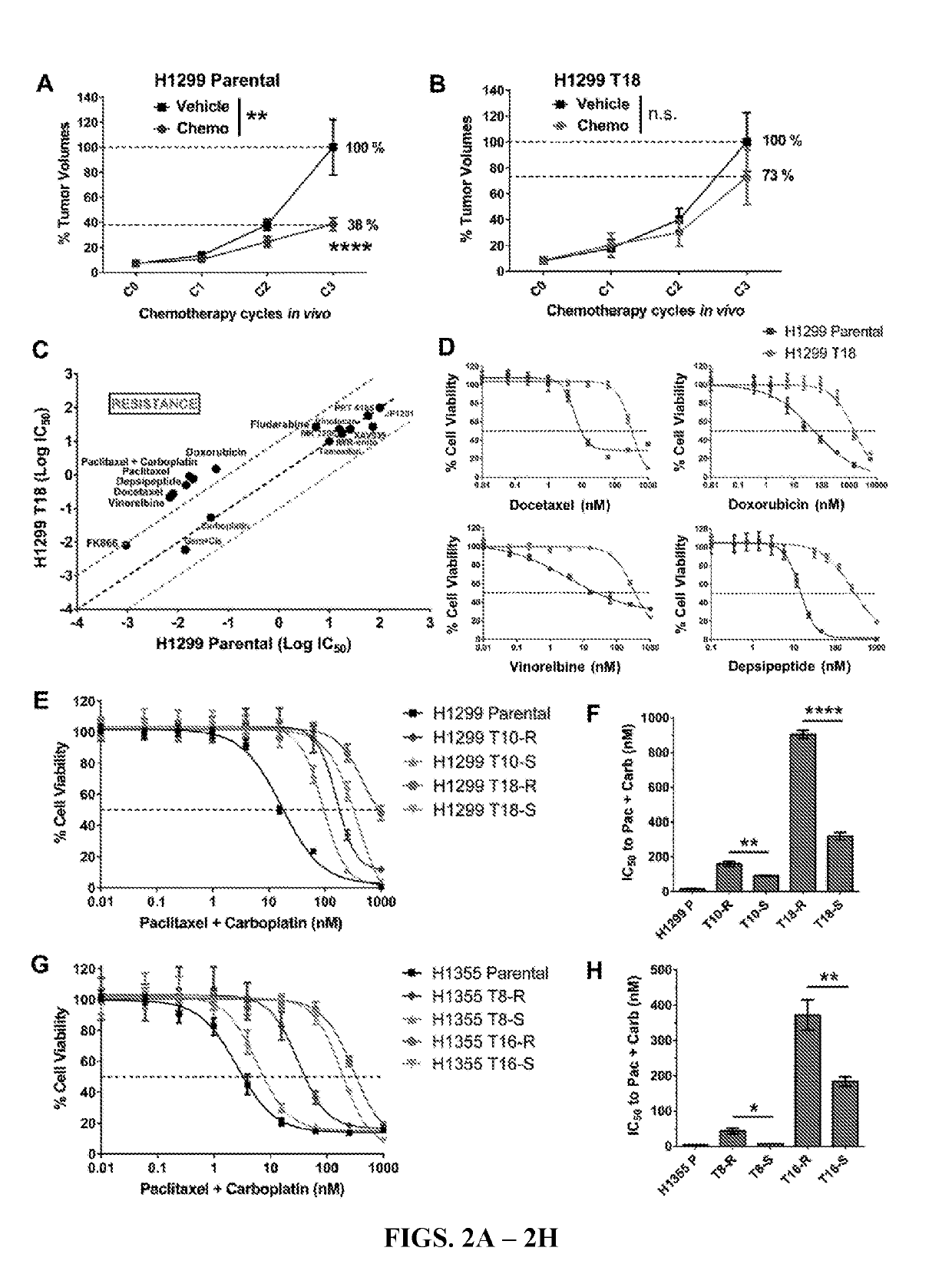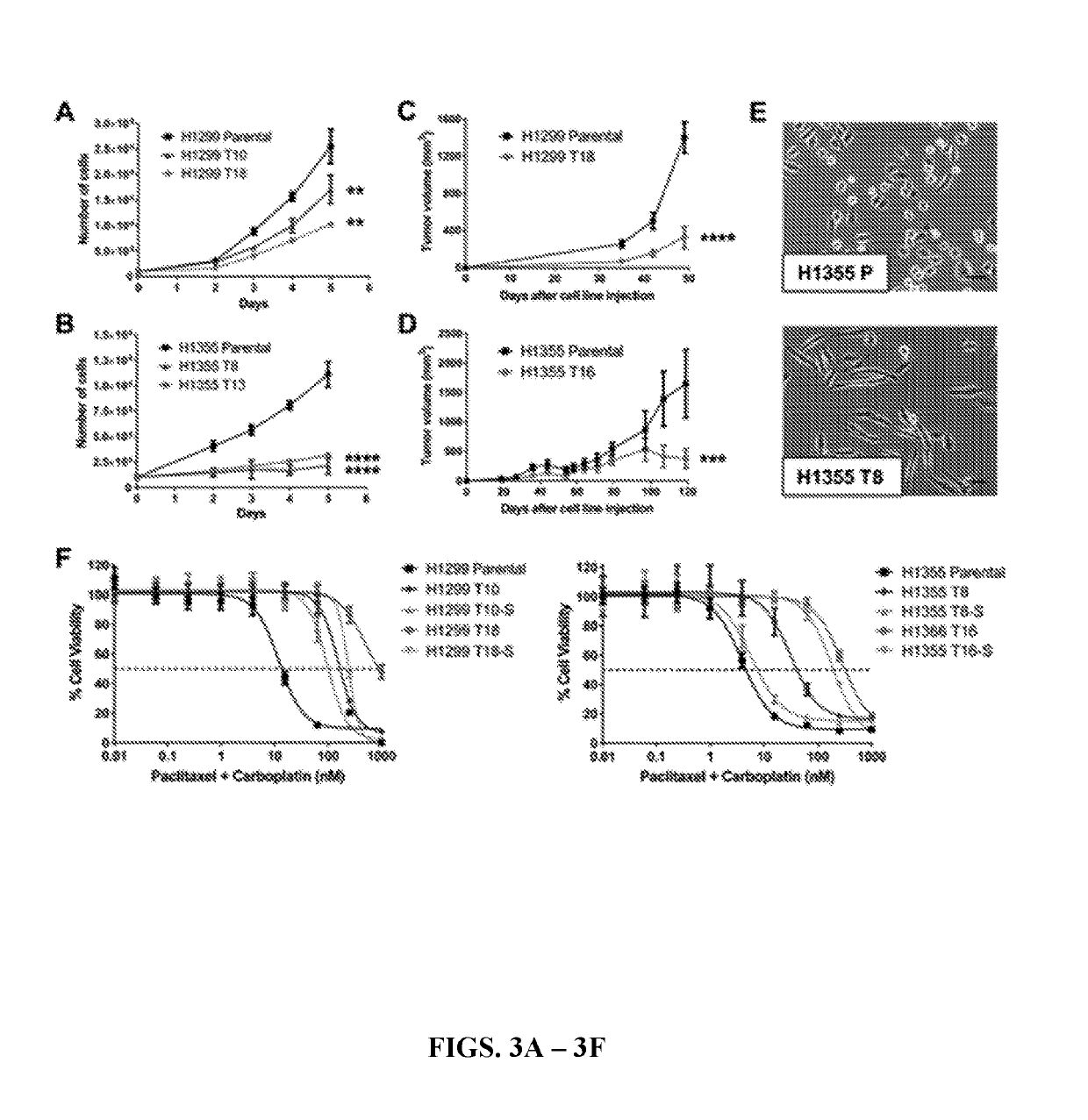Use of jumonji c demethylase inhibitors for the treatment and prevention of chemotherapy resistance and radioresistance in cancer
- Summary
- Abstract
- Description
- Claims
- Application Information
AI Technical Summary
Benefits of technology
Problems solved by technology
Method used
Image
Examples
example 1
Experimental Procedures
[0112]1. Cell Lines
[0113]NSCLC lines were obtained from the Hamon Cancer Center Collection (University of Texas Southwestern Medical Center). Cell lines have been DNA fingerprinted using PowerPlex 1.2 kit (Promega) and confirmed to be free of mycoplasma using e-Myco kit (Boca Scientific). Cells were maintained in RPMI-1640 (Life Technologies Inc.) with 5% FBS at 37° C. in a humidified atmosphere containing 5% CO2.
[0114]2. In Vitro Drug Treatment
[0115]NSCLC lines were treated with paclitaxel+carboplatin combination, given in a ˜2:3 wt / wt ratio, to mirror the clinical dosage values of ˜225 mg / m2 and ˜330 mg / m2, paclitaxel and carboplatin respectively. Note that considering the molecular weights of the two drugs, this translates to approximately a 1 to 3.4 molar ratio. Drugs were given in cycles, following a drug on / drug off treatment scheme. Each cycle consisted of 4-5 days of drug treatment and drug-free culturing for about 1-2 weeks or more to allow the surviv...
example 2
Long-Term Paclitaxel+Carboplatin Treated NSCLC Cell Lines Develop Progressive Increases in Chemoresistance
[0170]To establish in vitro models of lung cancer chemo-resistance, NSCLC cell lines were treated with paclitaxel+carboplatin standard chemotherapy combination given in a clinically relevant 2:3 taxane-platin ratio. Our ongoing tests of >100 NSCLC lines identified NCI-H1299 and NCI-H1355 among a group of NSCLC cell lines that were 100-500 fold more sensitive (had lower IC50 values) in 5 day MTS assays, than the most resistant NSCLC lines, and were thus selected as “parental” cells to develop drug resistant variants. Clinical annotations and driver oncogenotypes for these cell lines are listed in Tables 2 and 3.NCI-H1299 and NCI-H1355 cells were treated long-term for >6 months with increasing doses of paclitaxel+carboplatin doublet. Treatment was given in cycles of drug on (4 days) / drug off (1-2 weeks). Cells were characterized intermittently for their platin-taxane drug response...
example 3
Resistant Cell Line Variants Show Decreased Response to Taxane+Platin Chemotherapy In Vivo, Cross-Resistance to Multiple Drugs In Vitro, and Partial Reversal of Chemoresistance Upon Extended Drug-Free Culturing
[0171]To validate the taxane-platin resistance phenotype in vivo, subcutaneous xenografts of H1299 parental and H1299 T18 cells were developed and treated the tumor bearing mice with 3 cycles of taxane+platin chemotherapy. While H1299 parental xenografts treated with docetaxel+cisplatin therapy showed a dramatic reduction in tumor burden compared to the vehicle-treated group (two-way ANOVA, **P=0.002), H1299 T18 tumors showed a non-significant response, confirming resistance (FIGS. 2A-2B). This also confirmed the presumption that the tumors were cross-resistant to docetaxel+cisplatin standard therapy (drugs that are functionally equivalent to paclitaxel+carboplatin).
[0172]Consistent with previously published reports that suggested the involvement of MDR1 in taxane resistance (...
PUM
| Property | Measurement | Unit |
|---|---|---|
| Electrical resistance | aaaaa | aaaaa |
Abstract
Description
Claims
Application Information
 Login to View More
Login to View More - R&D
- Intellectual Property
- Life Sciences
- Materials
- Tech Scout
- Unparalleled Data Quality
- Higher Quality Content
- 60% Fewer Hallucinations
Browse by: Latest US Patents, China's latest patents, Technical Efficacy Thesaurus, Application Domain, Technology Topic, Popular Technical Reports.
© 2025 PatSnap. All rights reserved.Legal|Privacy policy|Modern Slavery Act Transparency Statement|Sitemap|About US| Contact US: help@patsnap.com



